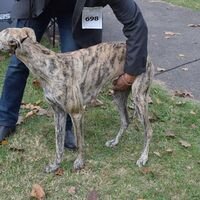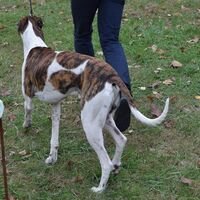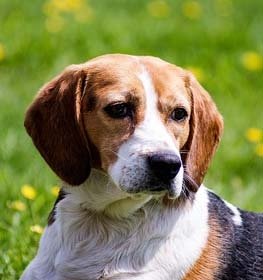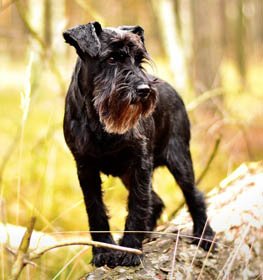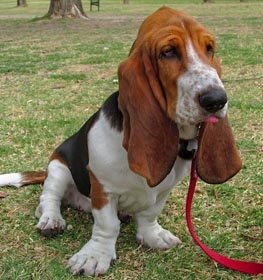Hungarian Greyhound Information & Dog Breed Facts
Collection of all the general dog breed info about Hungarian Greyhound so you can get to know the breed more.
| Group | Hunting Dogs |
|---|---|
| Popularity Rank | 265 |
| Reviews | 1 |
| User Ratings | |
|
Compare the Hungarian Greyhound With Other Dogs
Select at least one dog breed to make the comparsion. | |
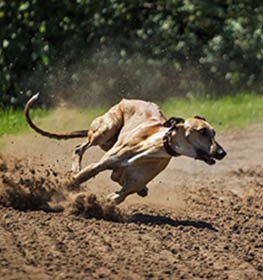 | |
| Origin | |
|
Common Names & Aliases
What other names is a Hungarian Greyhound known by? Discover all traditional, regional and informal names used for this breed. | Hungarian AgarHungarian GazehoundHungarian SighthoundMagyar AgarHungarian Greyhound |
|---|---|
|
Breed Classification
What type of dog breed is a Hungarian Greyhound? Learn about its genetic classification and breeding category. | Purebred |
Photo Gallery of the Hungarian Greyhound Breed
|
Size Classification
What size category is a Hungarian Greyhound? Learn how big the Hungarian Greyhound breed typically grows. | Large |
|---|---|
|
Weight Statistics
How much does a Hungarian Greyhound weigh? Discover typical weight ranges for adult males and females of the Hungarian Greyhound breed. | Male: 55-66 pounds (25–30 kg), Female: 52-64 pounds (23.5-29 kg) |
|
Average Weight
What is the average weight of a Hungarian Greyhound? | Male: 60.5 pounds (27.5 kg), Female: 58 pounds (26 kg) |
|
Height
How tall is the Hungarian Greyhound? Hungarian Greyhound height: | Male: 25-27 inches (63-69 cm), Female: 24-26 inches (61-66 cm) |
|
Average Height
What is the average height of a Hungarian Greyhound? | Male: 26 inches (66 cm), Female: 25 inches (63.5 cm) |
|
Price Range
How much does a Hungarian Greyhound puppy cost? Find current market prices and factors affecting Hungarian Greyhound costs. | $400-$800 If you choose to purchase the Hungarian Greyhound, you should know that the mentioned amount of money is an average of the collected data from breeders’ sites and puppy finder places. If you have a Hungarian Greyhound for sale, please advertise it on a reliable website to make sure the Hungarian Greyhound gets to a happy place. |
|---|---|
|
Availability
How easy is it to get a Hungarian Greyhound? How many Hungarian Greyhound are there in the world? | Average: The Hungarian Greyhound is a commonly available dog breed. There is less risk of overbreeding compared to the very popular dogs. Of course, they may be more popular in some countries, and inbreeding may occur, so be careful. |
|
Intelligence Rating
How intelligent is a Hungarian Greyhound? Discover the Hungarian Greyhound's intelligence ranking and learning capabilities. | Smart: The Hungarian Greyhound dogs have great intelligence. They understand and memorize new commands in 15-25 repetitions.
The Hungarian Greyhound is among the smartest dogs in the intelligence ranking. |
|---|---|
|
Training Difficulty
How easy is it to train a Hungarian Greyhound? Learn about the Hungarian Greyhound's trainability and response to training methods. | Hungarian Greyhound dogs are easy to train. They find out the association between commands and actions quite quickly. |
|
Watchdog Rating
How good is a Hungarian Greyhound as a watchdog? Learn about the Hungarian Greyhound's alertness and guarding instincts. | Hungarian Greyhound dogs are good watchdogs. Their main job is to observe and they're consistent in their effort. Good vocal cords and a sense of hearing belong to them. Usually, they're territorial and protective about their property, so the Hungarian Greyhound dogs will alert you if they sense something different.
|
|
Territorial Protection
Is a Hungarian Greyhound protective of its territory? Learn about the Hungarian Greyhound's guarding instincts and behavior. | Hungarian Greyhound dogs strongly protect their territory. This breed is a complete security guard, so you don't have to be afraid in case of danger. |
|
Personality Traits
What personality does a Hungarian Greyhound have? Learn about characteristic Hungarian Greyhound temperament and behavior traits. | EnergeticIntelligentDocileLoyalLivelyGentleTireless |
|---|---|
|
Sensitivity Level
How sensitive are they? Hungarian Greyhound sensitivity: | They are a little bit more sensitive than other dog breeds. Soft punishment affects them emotionally. Hungarian Greyhound dogs don't tolerate irregular daily routines, noisy households, and frequent guest visits really well.
They are receptive to their owner's emotions and make wonderful family companions. |
|
Affection Level
How affectionate are they? Is a Hungarian Greyhound a good family dog? | High: Hungarian Greyhound dogs are genuinely loyal, soft and gentle, loving, and affectionate dogs toward their handlers. They enjoy quality time with their owners despite the activity and are considered great therapy dogs for those in need. This breed responds strongly to their handler's emotions because they bond closely. Their happiness is your happiness. |
|
Social Needs
How much social interaction does the Hungarian Agar need? Hungarian Greyhound social needs: | Hungarian Greyhound dogs are kinda antisocial. This breed doesn't like being around people all the time, they tolerate being left alone. |
|
Impulse to Wander or Roam
How likely is the Hungarian Greyhound to run away? Does this breed explore or wander a lot? Does Hungarian Greyhound roam? | Hungarian Greyhound dogs have high wanderlust potential, which means that this breed has a strong desire for exploring the world. Safer to walk them on a leash unless you teach them how to get back to you on command. This breed is also able to cause damage to your fence. |
|
Prey Drive
Do this canine have a strong prey drive? Does Hungarian Greyhound have high prey drive? | Hungarian Greyhound dogs have a high impulse to chase and catch something. Cats or any other small animals are in danger. It's a natural instinct, doesn't necessarily mean that Hungarian Greyhound dogs are aggressive. Better to keep this breed on a leash. |
|
Barking Frequency
Does a Hungarian Greyhound bark a lot? Learn about typical Hungarian Greyhound vocalization patterns and triggers. | Low: The Hungarian Greyhound barks none to minimal. Perfect choice if you prefer a quiet breed.
Top reasons for barking: protection, alarm, fear, boredom, attention-seeking, greeting, separation anxiety, compulsive barking. |
|---|---|
|
Playful Nature
How playful is a Hungarian Greyhound? Understand the typical play drive and energy level of the Hungarian Greyhound breed. | Average: Hungarian Greyhounds, like any other dog breed, like playing. Sometimes they bark in excitement for playing, but they are not the most playful dog breed. |
|
Apartment Adaptability
Can a Hungarian Greyhound live in an apartment? Learn about the Hungarian Greyhound's suitability for apartment living. | Very house-friendly dog the Hungarian Greyhound breed. It's good if you have a small garden where he can go out and do his business, but it's not important at all. You can get enough exercise with one or two walks a day, so keeping them indoors shouldn't be a problem. |
|
Lifestyle Adaptability
How adaptable is a Hungarian Greyhound to lifestyle changes? Learn about the Hungarian Greyhound's flexibility to new situations. | Hungarian Greyhound dogs adapt very well to lifestyle changes and basically all living environments. They don't mind moving from one place to another with their owner. |
|---|---|
|
Alone Time Tolerance
Can a Hungarian Greyhound be left alone? Learn about the Hungarian Greyhound's tolerance to solitude. | Hungarian Greyhound dogs handle alone time quite well. They are not prone to have separation anxiety. |
|
Bite Risk Assessment
What is a Hungarian Greyhound biting potential? Learn about the Hungarian Greyhound's bite risk factors. | Low 🔽 The Hungarian Greyhound has a low chance of biting somebody. Top reasons for dog bite: protection, pain, excitement, herding instinct, being provoked. (Data based on the available online bite statistics.) |
|---|---|
|
Mouthing Tendency
Is a Hungarian Greyhound mouthy? Learn about the Hungarian Greyhound's tendency to use mouth during play. | Hungarian Greyhound dogs have a lower than average tendency to nip, chew, playbite, or herd people. It's a common habit during puppyhood, not aggressive behavior. These "bites" don't hurt, but Hungarian Greyhound dogs need to be taught a good attitude. |
|
Bite Strength Rating
How strong is a Hungarian Greyhound bite? Learn about the Hungarian Greyhound's bite force measured in PSI. | Between 200 and 400 PSI ⏺ Hungarian Greyhound bite force: Ordinary. Bite force Hungarian Greyhound measurements typically fall within the range of 200 to 400 PSI. The bite force of a Hungarian Greyhound is considered ordinary when compared to other dog breeds, but it is still quite powerful. This Hungarian Greyhound bite force PSI can cause bite wounds. Hungarian Greyhound bite PSI is not something that should be feared if the dog is well-trained and managed. To avoid any issues, it's essential to learn how to train a Hungarian Greyhound puppy not to bite from an early age.
The Hungarian Greyhound, and many others, have a fearsome presence because they have significant jaw strength, so it is important not to anger the dog and have it around strangers until it is fully trained. However, they are usually quite calm and good companions, they work well in families and are easy to care for. In conclusion, while the Hungarian Greyhound bite force is certainly an interesting aspect of the breed, it is important not to let it overshadow the many other reasons why these dogs are so loved and respected. With proper training and socialization, a Hungarian Greyhound can be a loyal and protective companion for your family. |
|
Average Lifespan
How long does a Hungarian Greyhound live? Learn about the typical lifespan of the Hungarian Greyhound breed. | 12-14 years The average lifespan of Hungarian Greyhound: 13 years |
|---|---|
|
Climate Tolerance
How well does a Hungarian Greyhound handle different weather? Learn about the Hungarian Greyhound's climate adaptability. | Prefers average to warm weather conditions Different dogs have different preferences when it comes to weather conditions. However, in general, most dogs prefer average to warm weather conditions, as they typically find hot weather conditions to be uncomfortable and taxing. |
|
Health Concerns
What health issues are common in a Hungarian Greyhound? Discover typical conditions affecting the Hungarian Greyhound breed. | Very healthy dog breed. The Hungarian Greyhound rarely meets with the veterinarian. |
|
Vet Care Frequency
How often does a Hungarian Greyhound need vet visits? Learn about the Hungarian Greyhound's veterinary care requirements. | Rare The Hungarian Greyhound should have a complete physical check-up at least every 12-18 months (but preferably once per year). If your dog shows any symptoms, call your veterinarian. |
|
Energy Rating
How energetic is a Hungarian Greyhound? Understand daily activity needs of the Hungarian Greyhound breed. | Hungarian Greyhound dogs are high-energy dogs. An active lifestyle makes them happy. |
|---|---|
|
Activity Requirement / Exercise Need
How much exercise does a Hungarian Greyhound need? How much exercise do Hungarian Greyhound dogs require per day?
Do Hungarian Greyhound dogs need a lot of exercises? | Hungarian Greyhound dogs need quite a lot of exercise. Daily walks should be on schedule. If you live an active life, this breed can be a good choice for you. |
|
Sleeping Need
How much sleep does the Hungarian Greyhound breed need? | Hungarian Greyhound dogs sleep 12-14 hours a day as an average dog and they're not considered a lazy breed. |
|
Obesity Tendency
Is a Hungarian Greyhound prone to weight gain? Learn about the Hungarian Greyhound's obesity risks. | Average to High: If you don't pay attention to the Hungarian Greyhound's weight, he can easily gain weight. More than one daily walk should be on schedule. To make your dog happy and fit, feed him with quality dry dog food and live an active life together. Try to find the happy medium between exercise and feeding.
If you notice any weight gain, consult your veterinarian and make a diet plan. Reduce unhealthy food and snacks, and measure the Hungarian Greyhound weight regularly. |
|---|---|
|
Food Consumption
How much food does a Hungarian Greyhound need daily? Learn about the Hungarian Greyhound's feeding requirements. | 2.5 to 3 cups of high-quality dry food a day, divided into two meals. |
|
Allergy Friendliness
Is a Hungarian Greyhound hypoallergenic? Learn about the Hungarian Greyhound's suitability for allergy sufferers. | No Hungarian Greyhound dogs don't do well with allergy sufferers by causing allergic reactions. Some dog breeds are even considered to higher possibility of an allergic response. Coat type isn't necessarily relevant, because most people are allergic to dander (flakes on the dog's skin) or saliva, not actually to dog hair. |
|---|---|
|
Coat Colors
What colors does a Hungarian Greyhound come in? Discover all possible Hungarian Greyhound color variations. | Cream White Brindle SpottedSpeckledMerleWhite & Brown Black & White |
|
Grooming Requirements
How much grooming does a Hungarian Greyhound need? Learn about Hungarian Greyhound coat maintenance requirements. | Effortless: The Hungarian Greyhound requires minimal grooming. Seasonal flea treatment is needed, but cutting the dog's hair by a professional groomer isn't necessary. Ears and eyes should be cleaned sometimes to avoid infections. Hungarian Greyhound is one of the best choices if you don't have the time, skill, or money to take care of a high-maintenance dog. Highly recommended for beginners. |
|
Drooling Tendency
Does a Hungarian Greyhound drool a lot? Learn about the Hungarian Greyhound's drooling habits. | The Hungarian Greyhound is a perfect example of a low drooling tendency. If you dislike being covered by slobber spots on your clothes, the Hungarian Greyhound could be a good choice for you. Drooling is the unintentional saliva flowing outside of the mouth. It can be completely normal or a sign of a health problem. Certain dog breeds drool less than others, just like the Hungarian Greyhound.
If you notice any change in your dog's drooling habit, you should contact a vet as soon as possible. |
|
Stinkiness Rating
Does a Hungarian Greyhound smell bad? Learn about the Hungarian Greyhound's natural odor levels. | Medium ⏺ The Hungarian Greyhound has an average chance of bad smell. Top reasons for dog stinkiness: infection of bad tooth/ear/skin folds, gas attacks. |
|
Coat Characteristics
What type of coat does a Hungarian Greyhound have? Learn about the Hungarian Greyhound's fur characteristics. | DenseRoughThick |
|
Bathing Needs
How often does a Hungarian Greyhound need baths? Learn about the Hungarian Greyhound's bathing requirements. | 6-8 weeks Rarely. Bathing your dog is beneficial to them in more ways than just one. It’s also a good time to look for unusual scratches, bumps, fleas, and other irregularities. When their hair is wet and flat against their body, these details are more visible.
For example, short-haired dog breeds can go a very long time in between baths. These short-haired breeds shed regularly and that shedding works to naturally remove excess dirt and oil. So unless your weenie dog got into the garbage can, you can probably hold off on a bath for a while. |
|
Shedding Level
How much do Hungarian Greyhound dogs shed? How to control, reduce and prevent the shedding of the Hungarian Agar? Do Hungarian Greyhound dogs shed a lot? | Hungarian Greyhound dogs are low shedders. It's a natural process of the hair growth cycle. The amount and frequency of hair loss mostly depend on their health status and breed type. |
|
Child Compatibility
Is a Hungarian Greyhound good with children? Learn about the Hungarian Greyhound's behavior around kids of different ages. | Hungarian Greyhound dogs are very kid-friendly dogs. This breed enjoys being surrounded by children.
|
|---|---|
|
Pet Compatibility
How well does a Hungarian Greyhound get along with other pets? Discover the Hungarian Greyhound's compatibility with other animals. | Hungarian Greyhound dogs do best when they’re the only pet at the family. |
|
Stranger Friendly
Are they aggressive or friendly towards/with strangers? Hungarian Greyhound temperament with other people: | Hungarian Greyhound dogs are average friendly towards strangers. |
|
Cat Friendly
How well do Hungarian Greyhound dogs get along with cats? Are they good with kittens? What is this fido's temperament with cats? Can they be good with cats? Can the Hungarian Greyhound breed live with a cat? | Hungarian Greyhound dogs are not cat-friendly dogs. |
|
Dog Friendly
Is Hungarian Greyhound good with other dogs? Are they dog-friendly dogs? How well do Hungarian Greyhound dogs get along with other dogs? | Hungarian Greyhound dogs are very dog-friendly dogs. If you want more dogs in your family or you'd like to join dog meetups, the Hungarian Greyhound can be a great choice. |
|
Good For First Time Owners
Is Hungarian Greyhound breed good for first-time owners? Do they make a good dog for novice owners? Is Hungarian Greyhound breed suitable for first-time owners? | Yes Hungarian Greyhound dogs are good for novice owners, due to their easy-going personality. |
|
Office Friendly
Are Hungarian Greyhound dogs good office canines? Do Hungarian Greyhound dogs make good office-friendly pets? Can they be office dogs? | No Hungarian Greyhound is not the best dog breed for office environment. |
|
Senior Citizens Friendly
Are they senior citizens friendly dogs? How well do Hungarian Greyhound dogs get along with the elderly people? What is the Hungarian Agar temperament with senior people? Are Hungarian Greyhound dogs good for elderly owners? | Hungarian Greyhounds are one of the best breeds for elderly people. |
|
Service Dog Capability
Can a Hungarian Greyhound be a service dog? Learn about the Hungarian Greyhound's service work potential. | Not really This breed generally not used as a service dog. A service dog is a term used in the USA to refer to any type of assistance dog specifically trained to help people who have disabilities, such as visual impairment, hearing impairments, mental disorders, seizures, mobility impairment, and diabetes. Service dogs are protected under the ADA (Americans with Disabilities Act).
Hungarian Greyhound is not the best breed for service purposes. |
|---|---|
|
Therapy Work Suitability
Is a Hungarian Greyhound good as a therapy dog? Learn about the Hungarian Greyhound's therapy work aptitude. | Not really This breed is generally not used as a therapy dog. A therapy dog is a dog that might be trained to provide affection, comfort, and love to people in hospitals, retirement homes, nursing homes, schools, hospices, disaster areas, and people with anxiety disorders or autism.
Hungarian Greyhound is not the best breed for therapeutic purposes. |
|
Scent Detection Ability
Is a Hungarian Greyhound good at detection work? Learn about the Hungarian Greyhound's scenting abilities. | Not really They are not typically employed for this type of work, but there may be exceptional cases. A detection dog or sniffer dog is a dog that is trained to use its senses (mostly its smell) to detect substances such as explosives, illegal drugs, wildlife scat, currency, blood, and contraband electronics such as illicit mobile phones.
Hungarian Greyhound is not the best breed for detection purposes. |
|
Search & Rescue Potential
Can a Hungarian Greyhound do search and rescue? Learn about the Hungarian Greyhound's SAR capabilities. | Not really This dog breed is not typically used as a search and rescue dog. The use of dogs in search and rescue (SAR) is a valuable component in wilderness tracking, natural disasters, mass casualty events, and locating missing people.
The Hungarian Greyhound is not the best breed for SAR purposes. |
|
Maritime Work Ability
Is a Hungarian Greyhound good on boats? Learn about the Hungarian Greyhound's maritime capabilities. | Not really Hungarian Greyhound breed usually doesn't like being on a boat. Boat dogs were typically bred for their strength, stamina, and water resistance, as they were often required to perform tasks such as pulling in fishing nets, and jumping into the water to retrieve ropes or lines, or helping to move cargo. Sailor dog is a type of dog that was bred to accompany sailors on their voyages. They were typically used for three purposes: as a working dog, a watchdog, and as a companion. A boat dog is a term used to describe a type of dog that was traditionally bred and used as a working dog on boats. |
|
Draft Work Capability
Can a Hungarian Greyhound pull carts? Learn about the Hungarian Greyhound's drafting abilities. | Not really A drafting dog or draft dog is a dog bred and used for cart pulling. Dogs bred for this work have strong builds and qualities that are needed, strength and determination.
Hungarian Greyhound is not the best breed for drafting purposes. |
|
Military Service Background
Was a Hungarian Greyhound used in military service? Learn about the Hungarian Greyhound's military history. | Not really In history, this breed was not really used for combat dog. |
|
Puppy Litter Size
How many puppies does a Hungarian Greyhound usually have? Learn about typical litter sizes. | 6-8 puppies |
|---|---|
|
Pregnancy Duration
How long is a Hungarian Greyhound pregnant? Learn about the Hungarian Greyhound's gestation period. | 60-64 days Reproductive cycle of the female Hungarian Greyhound: The first period called Proestrus lasts for about 9 days.
During this time the females start to attract males. You can notice by swelling vulva and bloody discharge. The second part is the Estrus when the female is receptive for the male. It lasts for about 3 to 11 days. The sign of the proestrus part is the soft and enlarged vulva. The discharge decreases and lightens in color. The third part is the Diestrus. Normally, it occurs around day 14. In this period the female’s discharge changes for vivid red and coming to its end. The vulva returns to average, and she will no longer permit mating. The fourth part called the Anestrus. The time frame between heat periods normally lasts about six months. |
|
Breeding Frequency
How often can a Hungarian Greyhound have puppies? Learn about safe breeding intervals. | Once a year. More frequent breeding is not healthy. It is very important not to buy a dog from a puppy mill, where the needs of the pups and their mothers are ignored. It's an inhumane high-volume dog breeding facility, where puppies born several times a year. |
|
AKC Classification
What AKC group is a Hungarian Greyhound in? Learn about the Hungarian Greyhound's AKC classification. | Not recognized by the American Kennel Club. |
|---|---|
|
FCI Classification
What FCI group is a Hungarian Greyhound in? Learn about the Hungarian Greyhound's international classification. | Not recognized by FCI. |
|
Kennel Club Recognition
Which kennel clubs recognize a Hungarian Greyhound? Learn about the Hungarian Greyhound's official recognition. | Federation Cynologique InternationaleUnited Kennel Club |
Hungarian Greyhound Pros and Cons
- Intelligence Rating: Smart: The Hungarian Greyhound dogs have great intelligence.
- Training Difficulty: Hungarian Greyhound dogs are easy to train.
- Health Concerns: Very healthy dog breed.
- Apartment Adaptability: Very house-friendly dog the Hungarian Greyhound breed.
- Grooming Requirements: Effortless: The Hungarian Greyhound requires minimal grooming.
- Shedding Level: Hungarian Greyhound dogs are low shedders.
- Drooling Tendency: The Hungarian Greyhound is a perfect example of a low drooling tendency.
- Watchdog Rating: Hungarian Greyhound dogs are good watchdogs.
- Mouthing Tendency: Hungarian Greyhound dogs have a lower than average tendency to nip, chew, playbite, or herd people.
- Lifestyle Adaptability: Hungarian Greyhound dogs adapt very well to lifestyle changes and basically all living environments.
- Alone Time Tolerance: Hungarian Greyhound dogs handle alone time quite well.
- Child Compatibility: Hungarian Greyhound dogs are very kid-friendly dogs.
- Dog Friendly: Hungarian Greyhound dogs are very dog-friendly dogs.
- Senior Citizens Friendly: Hungarian Greyhounds are one of the best breeds for elderly people.
- Good For First Time Owners: Hungarian Greyhound dogs are good for novice owners, due to their easy-going personality.
- Allergy Friendliness: Hungarian Greyhound dogs don't do well with allergy sufferers by causing allergic reactions.
- Obesity Tendency: Average to High: If you don't pay attention to the Hungarian Greyhound's weight, he can easily gain weight.
- Impulse to Wander or Roam: Hungarian Greyhound dogs have high wanderlust potential, which means that this breed has a strong desire for exploring the world.
- Cat Friendly: Hungarian Greyhound dogs are not cat-friendly dogs.
- Office Friendly: Hungarian Greyhound is not the best dog breed for office environment.
Hungarian Greyhound History
Introduction
Among Hungarian dog breeds, the Hungarian Greyhound is a true uniqueness. However, on the other hand, the breed is perhaps the least well-known four-legged Hungarian. Although the Hungarian Greyhound is a very valued and affectionate companion with remarkable hunting talent, the breed has been threatened with extinction multiple times during its existence. Due to its rarity, it has been crossed with other dogs over the years, which is why many people today do not consider that the Greyhound non-hunter kept for hobby purposes is a Hungarian Greyhound pure breed.
Origins
The ancestry of this Hungarian breed, like all Greyhounds, came from Egypt. According to the earliest discoveries, they originally appeared around the third millennium BC. Several other ideas and theories have been proposed as to how the breed was formed, but the only certainty is that the first archeological evidence for Hungarian Greyhounds was discovered in the Carpathian Mountains, which run along Hungary’s northern and easter borders. Around the 10th century, the breed first appeared in northern Hungary and the Great Alföld (Hungarian Plain), where Hungarian invaders used the dogs for hunting. However, as there is no evidence, it is unclear whether the breed existed before the Hungarians arrived in the Carpathian basin or it came with them. Although they have lived throughout the Great Alföld, they have had a strong hunting history in the three countries of Szabolcs-Szatmár-Bereg, Hajdú-Bihar, and Somogy. Furthermore, the breed became very popular in the days of Matthias Hunyadi. The king himself often spent his time hunting with them on horseback, however, after his death, with the country divided into three parts, the breeding of the Hungarian Greyhound started to decline. Moreover, under Turkish control, the breed was crossed with eastern greyhounds because it was the easiest way to hunt without attracting attention and hunting shifted from being a serious passion to poaching.
In the 19th-20th centuries
Moreover, in the 19th century the reformist count István Széchenyi popularized greyhound racing and as a result of this, the Hungarian Greyhound eventually became the national dog. Greyhound races were regarded as special and significant social events at the time. Almost every year, new organizations were founded to deal with the breed and its hunting. Horse and greyhound racing also attracted foreigners in Hungary. As a result, English thoroughbreds and the “Greyhound” were born. However, despite the fact that the Hungarian Greyhound’s speed was quick, it did not correspond to the speed of the English Greyhound. This led to the frequent crossing of the two breeds, through which the Hungarian Greyhound lost its distinctive personality.
Furthermore, after the Second World War, the breed was on the verge of extinction again. In 1963, a film about King Matthias was filmed for which Hungarian sighthounds were required. However, the Hungarian Greyhound was so uncommon than finding one in the country was nearly impossible. Kálmán Szigethy, a nature filmmaker, and hunter, located three specimens, acquired them and began breeding them for the film. The Hungarian Greyhound has resurrected thanks to Szigethy and was formally recognized by the Federation Cynologique Internationale in 1966. The breed has slowly but steadily spread over Europe since then, and it is no longer in danger of extinction.
Recognition
In 2004, all breeds of domestic dogs, including the Hungarian Greyhound, were declared a national treasure by the Hungarian parliament, and in 2017 it was even named Hungarian heritage dog. The Hungarian Greyhound was also recognized by the United Kennel Club in 2006.
Latest Hungarian Greyhound Compares
Hungarian Greyhound Names
How old is my Hungarian Greyhound in human years?
You May Also Like
Rate The Hungarian Greyhound Breed
Hungarian Greyhound Comments, Reviews and Questions
- Hope
Jan 1, 2020, 6:10:07 PM:





